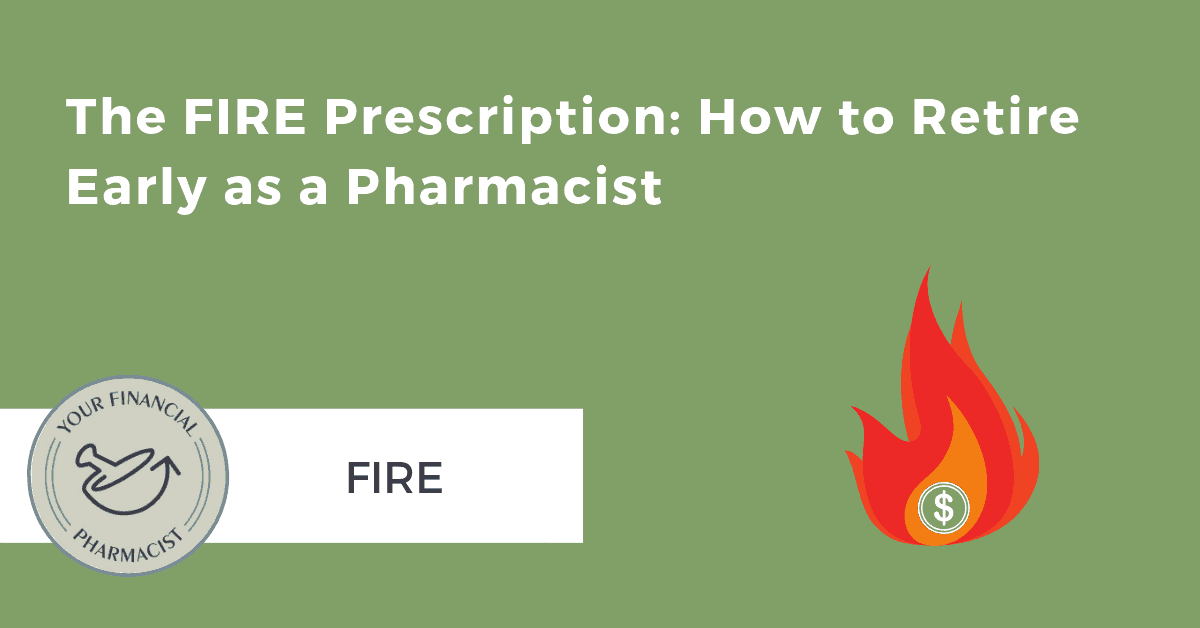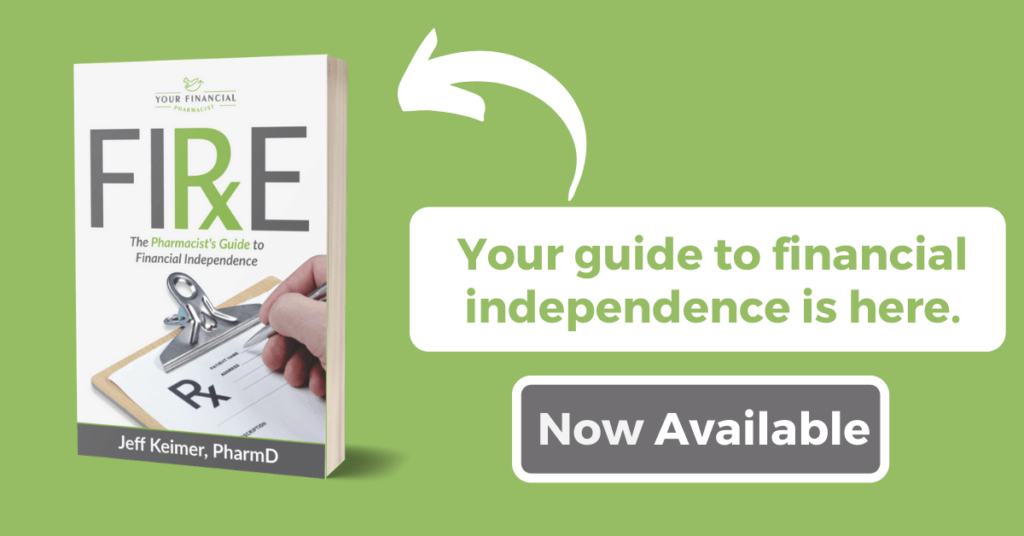The FIRE Prescription: How to Retire Early as a Pharmacist
The following is a guest post from Dr. Jeffrey Keimer. Dr. Keimer is a 2011 graduate of Albany College of Pharmacy and Health Sciences and pharmacy manager for a regional drugstore chain in Vermont. He and his wife Alex have been pursuing financial independence since 2016.
If you’ve started going down the internet’s personal finance rabbit hole, you’ve no doubt crossed paths with the FIRE movement. FIRE (financial independence, retire early) is a concept that’s been gaining a lot of traction lately. What was once considered a fringe topic, mostly covered by blogs such as Mr. Money Mustache or Early Retirement Extreme, has morphed into a widespread movement with mainstream coverage. Some are even calling it “the ultimate life hack.”
But what is it and why should it matter to us, pharmacists?
What is FIRE?
FIRE is based around the concept that it is possible to retire early (ie. before 65) by living off the income generated passively through investments. This is not a new concept. All throughout history, people have done this. You might think of this crowd as the 1%. So why all the buzz now?
Because it turns out, you don’t have to be a 1%’er to make it happen. Say what?!
How?
Because one of the core tenants of the FIRE movement is that the amount of money you need for retirement is purely a function of your expenses and NOT your income. You can control your expenses.
Should You Join the FIRE Movement?
But what about us? As pharmacists, we’ve sunk a lot of time and effort into getting where we are. So much so, that when people ask you what you do, you don’t respond with “Well, I work for company _____ in the _____ department,” you respond with “I’m a pharmacist.” What we do is embedded in our identities. So, you may ask yourself, why should I get into the FIRE movement? Surely, this whole retire early business is something only a cubicle worker who files TPS reports all day would dream about right?

Maybe, maybe not.
Maybe you feel burned out or you’ve just become disillusioned with our profession. That’s what one pharmacist, Jason Long of Tennessee, felt and decided FIRE was the way to go. In a NY Times article covering the FIRE movement, Jason cited burnout and job dissatisfaction as the primary reasons why he adopted a FIRE mindset and called it quits early.
He’s not alone in his feelings about the profession either. According to a recent article in Drug Topics, job satisfaction in pharmacy overall isn’t great with 29% of respondents to their survey indicating that they’d be looking for a new job in the next 12 months. Reasons cited: increased work volume and less help to do it. Factor in a more saturated job market, lower compensation packages, and the potential for Amazon to disrupt the whole industry with its Pillpack acquisition and there are plenty of reasons for a pharmacist to feel like their profession is on the ropes.
But maybe that’s not you. Maybe you love your job and love being a pharmacist. What then? Well, FIRE has something to offer you, too. In a word: options. Personally, I love being a pharmacist (I even work retail if you can believe it). Financial independence without the retire early angle can give you the flexibility to get more from your career. Mid-career residency? Part-time by choice? Want to start a business? In short, there’s a lot of power in not needing a paycheck.
How to Retire Early as a Pharmacist
Now that I’ve talked it up, it’s time to get down to brass tacks and layout a roadmap for FIRE. There are a few important concepts to understand, but before we get into that, I think it’s important to highlight some of the things that FIRE isn’t:
- A get rich quick scheme
- Some guru’s course
- A set formula
- Easy
That last one is the big one. FIRE is not something to go for on a whim or halfheartedly. It will not happen overnight. It will involve sacrifice and, probably, a fundamental change in your relationship to money. You need to have a good reason for pursuing FIRE if you’re going to be successful. In short, you’re going to need one heck of a WHY.
Got it? Great.
So how does it work? Like I said before, there are a few concepts that form the basis of the FIRE movement and here’s a good order to introduce them:
- Safe Withdrawal Rates and the “4% Rule”
- Reducing Expenses and Increasing Savings Rate
- Investing
- Drawdown
Safe Withdrawal Rates and the “4% Rule”
As mentioned before, FIRE philosophy focuses on expenses being the main variable in determining how much you need to retire. But the question remains: how much do I need? Luckily, the academics have provided that answer with what’s called a “Safe Withdrawal Rate” or SWR.
So what’s that? First, the long answer.
SWR refers to the rate (expressed as a percentage) that a retiree can realistically take out of their retirement portfolio, adjust for inflation every year, and never run out of money. Based on academic research, notably the Trinity study, this number has been said to be 4% when applied to a portfolio consisting of 50% stocks and 50% bonds. In that study, the authors looked at different mixes of stocks and bonds over different 30 year stretches from 1925-1995 to determine the probability of portfolio failure (ie. running out of money) when different withdrawal rates were applied. In all those scenarios, it was determined that a person who took out 4% of the portfolio and then adjusted their subsequent withdrawals for inflation going forward had a 0% chance of running out of money at the end of the 30-year period. From this, we get what’s known as the “4% rule.”
In short, if you divide your yearly expenses by 0.04 (or multiply by 25!) you come up with a portfolio balance (your FIRE number) that can provide a stream of income to cover your expenses for at least 30 years, if not indefinitely. Now, this is somewhat of an oversimplification, which is why 4% being a “rule” needs to be taken more as a guideline, but you get the gist. In today’s environment, SWRs might be lower, but for now, you can estimate your FIRE number like this.
Yearly Expenses*25 = FIRE Number
For perspective, that means $1,000,000 can provide you with a $40,000/yr (plus inflation) forever.
Reducing Expenses
Since how much you spend is what determines how much you need to save, cutting expenses really accelerates the whole process. Frugality is your friend. Just think, if you’re spending $100/month on cable and decide to cut the cord, that’s an extra $30,000 you DON’T need to save. What about a car lease payment? Or a McMansion? Then we’re talking in the hundreds of thousands to MILLIONS less.
Note too, that by cutting expenses, you also free up money to save. The rate that you save (taken as a percentage of income) is what really determines how long it will take for you to reach financial independence. To illustrate this point, we’ll use an early retirement calculator.
- Assume Bob is a 24-year-old new practitioner making $120,000/year gross with no prior savings and a 5% rate of return on investments.
- If after taxes and expenses, Bob can save $18,000 per year (15%), he will hit financial independence in about 43 years at the age of 67. This is pretty standard retirement savings advice, by the way.
- However, if Bob can jack up his savings rate to 30%, he can now retire in 28 years at the age of 52.
- And, if Bob goes all-in on FIRE and gets that rate up to 50%, he can retire in a little under 17 years. Just after he turns 40. Bob wins.
See, math can be fun!
But cutting expenses isn’t just about choosing to go without cable or driving a more sensible car, it’s also about getting out of debt. Debts are expenses just like any other and should be dealt with as part of your FIRE plan.
Unfortunately, this is the stage of the FIRE journey that involves the most pain. In a way, it’s like committing to losing weight. Your budget is your diet and you’re only going to get the results you want by sticking to it. Thankfully, maintaining a budget is easier than ever thanks to apps such as YNAB and Mint.
Speaking of debt, even if you’re not fully sold on FIRE, getting out of debt is transformative and something everyone should strive for. I don’t agree with Dave Ramsey on much, but he is right when he says, “the borrower is a slave to the lender.” Debt such as student loans, car loans, credit cards, etc., chains you to work in a way that’s just unhealthy. You can have the greatest job ever, but if you need your whole paycheck to service your debts, your relationship with your work is going to suffer and you’ll probably start resenting it.
That said, there’s one important caveat to getting out of debt that pharmacists should keep in mind. Bringing the full-on beans and rice diet intensity to your student loans may not be the best course of action if you can qualify for loan forgiveness. With FIRE, optimization is key. You may find it more profitable in the long run to forgo paying off your student loans outright if you qualify for some of these programs. Check out this YFP podcast episode on how to optimize forgiveness.
Another way to reduce your expenses could be refinancing your student loans or mortgage. Lowering your monthly payment on your mortgage or student loans will likely save you a lot of money each month. With these additional savings, you could put even more toward knocking out your debt! While student loan refinancing isn’t for everyone especially if you’re pursuing PSLF or non-PSLF loan forgiveness, you could earn up to $800 in a cash bonus from a reputable company YFP has partnered with!
NMLS ID: 1681276
320 Blackwell Street
Suite 200
Durham, NC 27701
Investing
The umbrella of “investing” covers a wide range of topics but in this article, I’m only going to briefly touch on the two major types of investments most pharmacists will encounter on their journey to FIRE: paper assets and real estate.
Paper assets are those such as stocks and bonds that you can invest in using 401(k)s, 403(b)s, 457s, IRAs, and brokerage accounts. These are the types of assets that generate truly passive returns and, with a properly diversified portfolio, can make FIRE possible. That said, there’s no one way to go about investing in these.
Within the FIRE community, index investing strategies (aka. indexing), such as those advocated by JL Collins, are quite popular. Central to indexing is the focus on low-cost index mutual funds. What are those? Without getting too much into the weeds, they’re mutual funds that give investors a diverse basket of stocks or bonds (sometimes all of them) at little or no cost. In general, these strategies call for a gradual decline in the proportion of stocks (high risk, higher return) to bonds (low risk, lower return) over time. And, while this isn’t different from the conventional approach to investing, the emphasis on using funds with low costs can make the whole process more efficient. Is indexing the best way to go about FIRE? Maybe, maybe not. However, it is one of the most accessible and can get you started.
Beyond stocks and bonds, many FIRE devotees choose to invest in real estate. In addition to acting as an asset that isn’t correlated with either the stock or bond markets, real estate investing can provide a level of passive income that can decrease the amount of money you need to save in paper assets. While not necessary to FIRE, many investors find real estate to be a worthwhile pursuit and can accelerate your path.
Drawdown
Finally, after amassing your war chest, you need a way to get at it. Since the primary vehicle most people use is a retirement account, how do you get the money out before regular retirement age? Fortunately, the FIRE community’s good at finding loopholes. Between Roth IRA laddering, 72(t) distributions, or simply taking the money out at a lower tax rate and paying the penalty, there are ways to jailbreak your money in a way that makes sense.
How to Join the FIRE Movement
So how do you get started? First and foremost, make a commitment to taking control of your finances and making them a priority. Second, get your spouse or significant other on board (super important!). Third, take action in a way that makes sense for you. Lastly, join others in the FIRE movement by connecting with groups online. FIRE isn’t just a movement but a community.
So, if this all sounds good, I invite you to take charge and change your life.
Welcome to FIRE!





